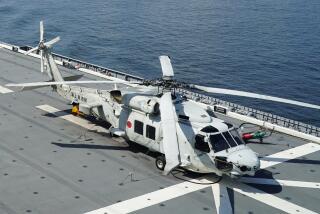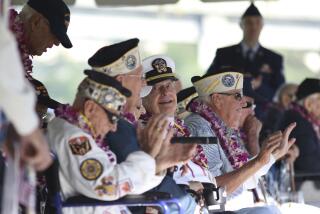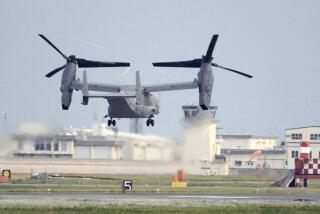Japanese Sub Wreck May Offer Clues U.S. Fired First in WWII
- Share via
HONOLULU — A Japanese midget submarine sunk before the attack on Pearl Harbor has been found by researchers who stumbled across the vessel while doing training dives.
Discovery of the 78-foot submarine Wednesday could provide the first physical evidence to back U.S. military assertions that it fired first against Japan in World War II and inflicted the first casualties.
The sub was sunk by a Navy destroyer on Dec. 7, 1941. The remains of two Japanese crewmen are believed still inside the submarine.
“It’s the shot that started World War II between the Americans and the Japanese,” said John Wiltshire, associate director of the Hawaii Undersea Research Laboratory, which found the sub.
The two-man submarine was discovered at a depth of 1,200 feet and a few miles from Pearl Harbor by research craft making test dives, he said.
The sub led four other Japanese midget submarines to Pearl Harbor to take part in the attack. The newly discovered sub was believed to be the one sunk by the destroyer Ward more than an hour before the attack.
Wiltshire said the crew is certain that this sub was sunk by the Ward because of a bullet hole in the conning tower and because it still has both torpedoes. Three of the subs have been previously accounted for; the remaining sub had fired both of its weapons.
Until the submarine was found, historian Daniel Martinez said eyewitness accounts were unconfirmed. Martinez, a historian for the battleship Arizona Memorial, has interviewed the crew who fired the first shot, and a pilot who saw the submarine sink.
“What they saw and what they felt was their recollection. Now the proof has been found,” he said.
The submarines’ entry into the harbor was followed by the Sunday morning attack by Japanese planes that lasted two hours and left 21 U.S. ships heavily damaged, 323 aircraft damaged or destroyed, 2,390 people dead and 1,178 others wounded.
“The finding is an important piece of historical evidence because it backs up Japan’s attempt to conduct a surprise attack,” said Yoshiaki Yoshimi, a historian at Tokyo’s Chuo University.
Terry Kerby, chief pilot of the deep-diving submersible that found the submarine, said it was covered in growth but was in excellent condition.
“To actually come across it was a sobering moment, realizing that was the shot that started the Pacific war,” he said.
Kerby and other researchers have been conducting dives in the area since the 1980s, and they have always known the sub was somewhere out there.
More to Read
Sign up for Essential California
The most important California stories and recommendations in your inbox every morning.
You may occasionally receive promotional content from the Los Angeles Times.













